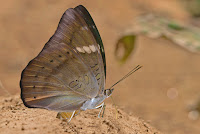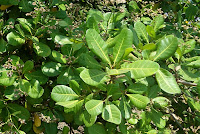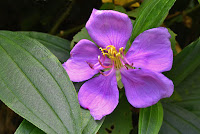<> Euthalia aconthea (Cramer,[1777]) <>
the Common or Mango Baron ผีเสื้อบารอนหนอนมะม่วง
Click on any photo to see all photos full size in Lightbox
Additions and corrections to the information provided on this page is always welcome. Please use the Contact form.

Photo taken at Doi Suthep-Pui National Park, Chiang Mai. Thailand ♂ 450m a.s.l.

This species is fairly common and distributed throughout the whole region of SE Asia. The species is dimorphic and the sexes look very different with the female also being larger. Unusually, the female is often seen. The base colour of the wings is usually brown but not always (as can be seen in the photos below) and the colours within the markings can be quite variable, especially in the male. Like other species in this genus it is a strong flier but usually flies quite low.
Euthalia aconthea flies all year round and is multivoltine with several broods per annum. The adult female lays her eggs singly on the underside of a leaf on the host plant. The larvae feed mostly at night.
Synonyms and previously used names: Papilio aconthea, Euthalia merilia, Euthalia garuda, Euthalia apama, Aconthea primaria, Euthalia primaria, Nymphalis disconthea, Adolias garuda
Taxonomy: Animalia - Arthropoda - Insecta - Lepidoptera - Nymphalidae - Limenitidinae - Euthalia - aconthea
Regional subspecies: E.a.garuda (NE India, Myanmar, N.Thailand, Cambodia), E.a.gurda (S.Thailand, Malaysia), E.a.kingtungensis (Yunnan, China), E.a.palawana (Philippines), E.a.suddhodana (Nepal). There are also a number of different subspecies recorded throughout the islands of Indonesia and the Philippines.
Regional Distribution: India, Nepal, Bhutan, Bangladesh, Myanmar, Thailand, Laos, Cambodia, Vietnam, China, Mayalsia, Singapore, Indonesia, Philippines
 |
| Doi Suthep-Pui National Park, Chiang Mai, Thailand ♀ 1150m a.s.l. |
Habitat: Euthalia aconthea is found mainly in evergreen and deciduous montane forest. However, due to the widespread use of mango trees it is also found in urban areas. Often seen near water and has been recorded at elevations up to 2000m a.s.l. in the eastern Himalayas.
Flight time: all year round, depending on location Wingspan: 55-75mm
Life History: egg 5 days instar 1 3 days instar 2 3 days instar 3 3 days instar 4 7 days instar 5 10-11 days pupa 9 days Total egg to adult 40-42 days. All times are approximate.
Larval Hosts: Anacardium occidentale, Mangifera indica, Nothopegia beddomei, Toxicodendron succedaneum (Anacardiaceae), Morus alba, Streblus asper (Moraceae), Ziziphus mauritiana (Rhamnaceae), Scurrula gracilifolia, Scurrula parasitica (Loranthaceae). Actual host plant used depends upon location and availabilty of plant species.
Adult Food Sources: Nectar - Varronia cylindristachya (Boraginaceae), Melastoma malabathricum (Melastomataceae), Pseuderanthemum maculatum (Acanthaceae). There may be other nectar sources that have not yet been recorded. Other - mud puddling, tree sap, rotting fruit, and bird droppings.
 |
| Doi Suthep-Pui National Park, Chiang Mai, Thailand ♂ |
 |
| Doi Suthep-Pui National Park, Chiang Mai, Thailand ♂ |
 |
| Doi Suthep-Pui National Park, Chiang Mai, Thailand ♂ |
 |
| pupa |
 |
| Doi Suthep-Pui National Park, Chiang Mai, Thailand ♀ |
 |
| Doi Suthep-Pui National Park, Chiang Mai, Thailand ♀ |
 |
| Doi Suthep-Pui National Park, Chiang Mai, Thailand ♀ |
 |
| Doi Suthep-Pui National Park, Chiang Mai, Thailand ♂ |
 |
| Anacardium occidentale, a larval host |
 |
| Mangifera indica, another larval host |
 |
| Melastoma malabathricum, a nectar source |
 |
| Pseuderanthemum maculatum, another nectar source |
Links to other pages in this series for species in the same subfamily
Athyma perius
Auzakia danava
Euthalia alpheda
Euthalia lubentina
Lasippa viraja
Limenitis asura
Neptis cartica
Neptis miah
Pantoporia hordonia
Sumalia daraxa
Athyma pravara
Bhagadatta austenia
Euthalia anosia
Euthalia monina
Lebadea martha
Limenitis dudu
Neptis clinia
Neptis nashona
Pantoporia paraka
Sumalia zulema
Athyma ranga
Cynitia cocytus
Euthalia evelina
Euthalia patala
Lexias dirtea
Moduza procris
Neptis hylas
Neptis nata
Parthenos sylvia
Tanaecia jahnu
Athyma selenophora
Euthalia aconthea
Euthalia franciae
Euthalia phemius
Lexias pardalis
Neptis ananta
Neptis magadha
Neptis soma
Phaedyma columella
Tanaecia julii
